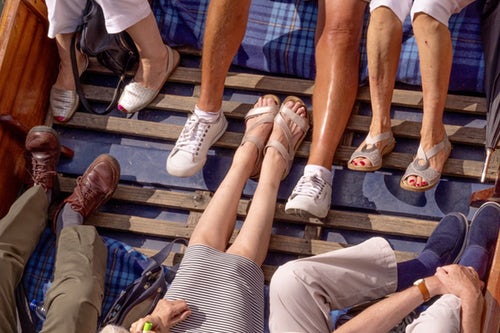Ever have a big, fiery red puffed up blister on your foot, toe or heal? Not a lot of fun, is it? It can make shoe wearing and even walking miserable or nearly impossible. And they can take SOOO L-O-N-G to heal.
I saw and treated a lot of blisters in my day as an athletic trainer. There was a special process we’d go through to lance, drain, pack and pad them, so the athlete could bite their lip and return to practice or competition. And I still find myself treating my own today.
But a lot of those blisters could have been avoided. Some of the blister-causing culprits I saw were:
- Improperly fitted shoes.
- Shoes that had gotten wet and dirty and, consequently, dry and stiff. No pliability left.
- Too old or too worn out shoes. (Sometimes athletes just couldn’t relinquish them.)
- Wrong shoes for the activity. Tennis for running. Running shoes for tennis.
- Old, dirty socks worn, worn and re-worn until they could stand up on their own.
- Worn out socks with pills, errant threads floating around, threadbare areas and holes.
- Shoes stiffened from sweat.
- Socks that didn’t fit.
- Wrong sock for the wrong activity.
- Dirty feet and toes.
- Improperly trimmed toenails.
- Untrimmed toenails.
- Feet not properly dried following a shower or sweat-inducing exercise.
- Grit and dirt in the shoes or socks.
- Old insoles that needed to be replaced.
- Calluses that hadn’t been cared for properly or filed down sufficiently.
- Doing too much too soon on soft, unconditioned feet.
Did I say doing too much too soon on unconditioned feet?
That last one is probably one of the biggest culprits. Feet need to be conditioned to do the work you expect of them. You need to work up to the mileage and pace you want to maintain.
Blister Care—
Some things have changed about blister care since I was treating them daily. Some of the super neat treatment options were arriving on the scene while I was still in school learning how to be an injury-preventing, injury-identifying, and recovering-from-injury athletic trainer. Our understanding of how blisters are caused has evolved, and that understand has allowed developments in better treatment.
But there is no one-type-of-prevention-fits-all to follow.
You can conquer and reduce the number and severity of blisters if you know the basics.
NEXT WEEKI’ll take you through the physics of blister formation. Then we’ll talk about how to reduce their occurrence and treat them if they do arise. Literally.
Until then,
look through your closets and drawers for socks that have seen better days and need to be retired to the laundry room as rags. (Hint: look for thread bare areas, broken down weave, holes, runs, pilling, and stretched out elastic. Thank the socks for their faithful service, and then use them for something else.)
Blessings,
Andrea
May you prosper in all things and be in health, just as your soul prospers (3 John 2).
Photo by Craig Whitehead
